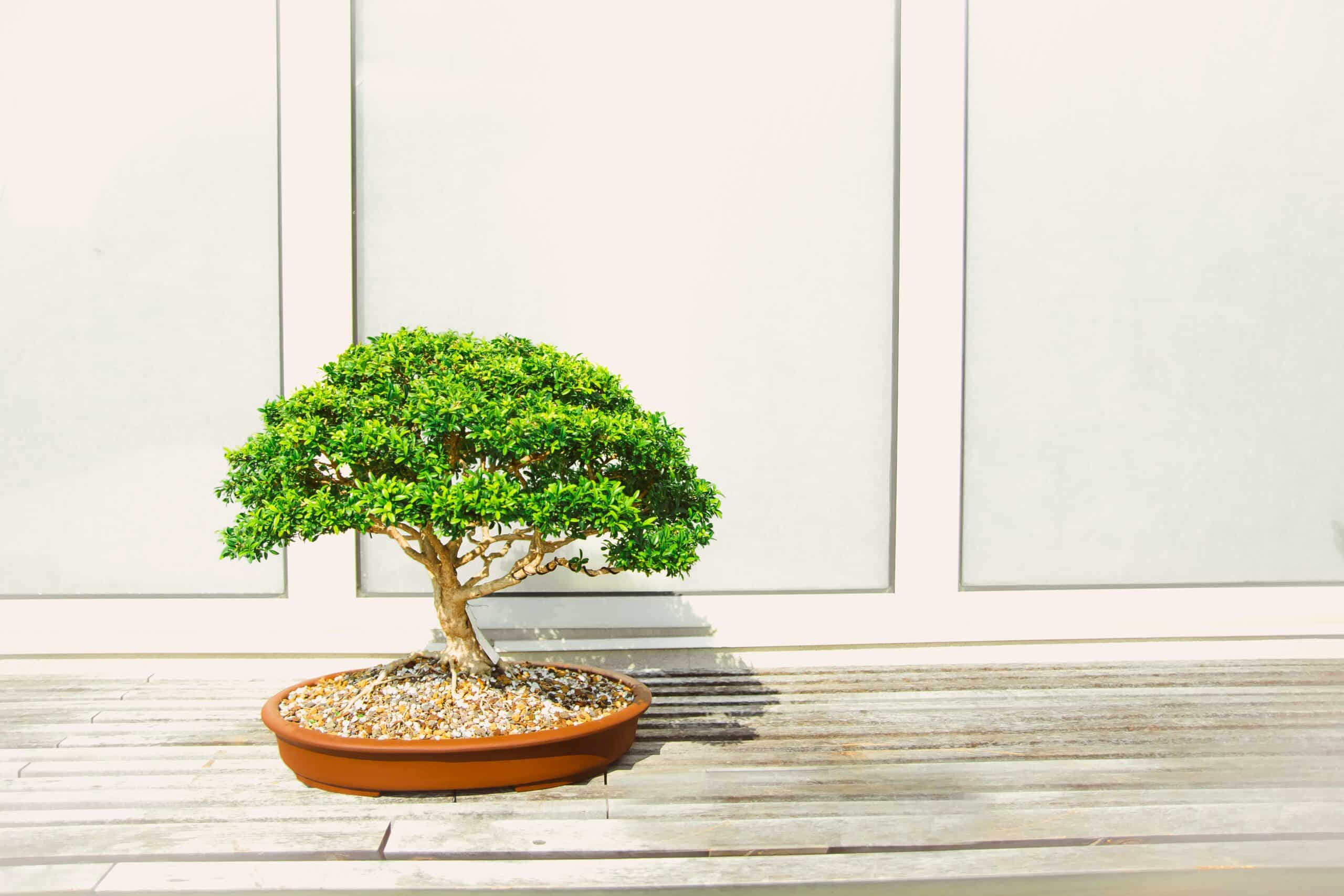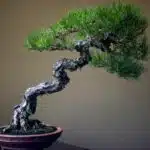Caring for bonsai is like a dance; it takes grace, patience and skill to create a beautiful masterpiece. The ginseng ficus bonsai is a unique variety that provides an especially rewarding challenge for those devoted to this craft. With its strong, yet delicate roots and vibrant leaves, the ginseng ficus bonsai is both captivating and resilient. This article will provide an in-depth guide on how to grow and care for this special plant.
For those interested in cultivating a ginseng ficus bonsai, there are several key considerations when it comes to selecting the right soil, water, sunlight and pruning methods. It is important to ensure you have the proper environment for your bonsai so that it can thrive over time. Additionally, understanding the subtle nuances of this particular species will help you achieve the desired aesthetic result as well as keep your plant healthy.
Finally, while caring for a ginseng ficus bonsai can be challenging at times, following these guidelines can bring you immense joy and satisfaction – not just from growing a stunningly beautiful tree but also from serving others by providing them with lovely home décor or thoughtful gifts!
What Is A Ginseng Ficus Bonsai?
The beauty of bonsai lies in its ability to bring a piece of nature into our homes. But, what is a ginseng ficus bonsai? It’s an original species that has been carefully cultivated and pruned over many generations to create the perfect miniature tree. Ginseng ficus bonsais are known for their stunning trunks, which twist and turn like coiling snakes, as well as their delicate leaves and small size. While these trees require careful attention to detail, they can be very rewarding for those with the patience and dedication to care for them properly.
Caring for a ginseng ficus bonsai requires knowledge about the species’ specific needs. This includes providing the tree with adequate sunlight, water, and fertilizer – all of which must be done in moderation. Additionally, regular pruning helps keep the shape of the tree balanced and healthy. Lastly, it’s important to keep an eye out for pests or disease that could potentially threaten your tree’s health. With proper care, your ginseng ficus bonsai could live for decades!
For anyone looking to start cultivating their own ginseng ficus bonsai, it’s important to purchase a high-quality tree from a reliable source. Look for trees with healthy foliage and an attractive trunk pattern that meets your preferences – this way you can ensure you’re getting a quality specimen that you can nurture into something beautiful!
Where To Buy Ginseng Ficus Bonsai
If you’ve been searching for the perfect addition to your bonsai collection, then look no further! The ginseng ficus bonsai is the most stunning and sought-after specimen out there. With its delicate leaves and intricate trunk design, it’s truly a sight to behold – and it can be yours with just a few simple steps.
First off, let’s discuss where to buy ginseng ficus bonsai. You’ll find that most garden centers and nurseries carry these beautiful plants in limited quantities. Online retailers are also great sources for finding them, as they tend to have larger selections and may even offer special discounts or deals. You can also check your local classifieds for people who are selling their own personal specimens or cuttings from established trees. However you decide to purchase your ginseng ficus bonsai, make sure it looks healthy before bringing it home.
When selecting a healthy ginseng ficus bonsai, be sure to inspect the tree carefully for signs of disease or damage. Check the leaves for discoloration or wilting – if they don’t look vibrant green and healthy, this could be an indication that something is wrong with the tree. Additionally, assess its trunk shape – it should have an interesting twist or curve but shouldn’t appear gnarled or bent out of shape. Finally, look at the roots – they should be firmly rooted in well-draining soil with minimal exposed root mass showing above ground level. Once you’re sure your ginseng ficus bonsai is in good condition, you’re ready to take it home and start caring for it!
How To Select A Healthy Ginseng Ficus Bonsai
When selecting a ginseng ficus bonsai, it is important to know that there are over 800 species of this plant. That’s right–800! So finding the perfect one can be a daunting task. However, with a few easy tips and tricks, you can find the ideal ginseng ficus bonsai for your home or garden.
First, look at the appearance of the tree. Make sure that the leaves are vibrant and not wilting or yellowing. The trunk should be straight and free from any deformities or splits. If you can, inspect the roots to see if they appear healthy and free of pests or diseases. Additionally, when inspecting the foliage of your potential bonsai, look for any spots or discoloration which could be an indication of an infection.
Finally, ask questions about how old the tree is and where it was grown as these factors will also influence its health and growth rate. It is essential to choose a tree that has been properly cared for in order to get the most out of your bonsai experience. Once you have selected a healthy tree, it’s time to learn how to repot your ginseng ficus bonsai so that it will thrive in its new home!
Repotting Your Ginseng Ficus Bonsai
Repotting your ginseng ficus bonsai is an important part of its care. By repotting every two to three years, you can give your bonsai a fresh start and help it to thrive. Here’s what you need to know about the process.
First, carefully remove the bonsai from its existing pot. Make sure to loosen any roots that may have become matted around the edges of the pot or on its surface. Then, select a new container with holes in the bottom for proper drainage and fill it with a soil mix specifically designed for bonsais. When placing your ginseng ficus into its new home, be sure to make sure that it is not too deep within the soil. It should rest slightly above the rim of the pot.
Finally, pat down lightly around the root ball so that your bonsai is firmly in place and then water thoroughly. This will help settle any air pockets that might exist in the soil and ensure your tree has plenty of moisture for its new home.
Now that you’ve repotted your ginseng ficus bonsai, it’s time to look at soil requirements for optimal health and growth. The right mix of soil components can make all the difference when it comes to keeping your bonsai healthy and happy!
Soil Requirements For Ginseng Ficus Bonsai
As the saying goes, ‘a good tree needs strong roots.’ The same is true for cultivating a healthy ginseng ficus bonsai. The fifth step in growing and caring for this unique plant is understanding its soil requirements. To have a thriving bonsai, it’s important to know what kind of soil it needs and how to provide the best environment for its growth.
First, let’s talk about the type of soil that ginseng ficus bonsai need. The best soil mix should be well-draining and provide plenty of aeration. A mixture of equal parts akadama, pumice, and lava rock can provide the ideal balance needed for your bonsai to thrive. If you’re having difficulty finding these materials at your local nursery or garden center, you can also purchase an all-purpose bonsai soil mix designed specifically for this purpose.
Once you’ve selected the right kind of soil, you’ll need to make sure it’s watered correctly. Ginseng ficus bonsais prefer moist but not soggy soils, so water thoroughly when necessary and always avoid letting standing water remain in their potting tray or dish. Additionally, fertilizing once every two weeks with a dilute solution of organic liquid fertilizer can help promote healthy growth and blooming.
By providing the right type of soil with regular watering and fertilizing, you’ll be setting up your ginseng ficus bonsai for success! By following these steps, your bonsai will have everything it needs to grow strong roots and put forth beautiful foliage year-round.
Light Requirements For Ginseng Ficus Bonsai
A ginseng ficus bonsai is a beautiful and rewarding addition to any garden. As with all bonsais, light is paramount for its growth and health. Like a beacon of hope, light requirements for a ginseng ficus are essential in order to nurture and sustain it.
When it comes to placement, the best spot for your ginseng ficus bonsai is near a window that receives plenty of natural light throughout the day. It should be placed so the sun’s rays reach the pot directly but not cast harsh shadows over it. If this isn’t possible, you can supplement natural light with fluorescent lamps or full-spectrum bulbs.
In terms of positioning, your ginseng ficus should be placed so that it receives at least 4 hours of direct sunlight every day during spring and summer months. During autumn and winter months, reduce this amount to 2-3 hours of direct sunlight each day as these plants prefer bright indirect light during cooler times of year.
With adequate amounts of light, your ginseng ficus will grow strong and healthy while producing lush green foliage. Now that we’ve discussed light requirements for growing your bonsai tree, let’s move on to watering it properly…
Watering Your Ginseng Ficus Bonsai
Watering a ginseng ficus bonsai is like giving it a hug, as it’s essential for keeping the plant healthy and happy. As an ancient symbol of balance, this special bonsai needs just the right amount of water to stay in harmony with its environment. Too little and your tree will be thirsty; too much and you’ll risk root rot and other diseases.
A good way to think about watering your tree is to imagine that it’s thirstier in summer than winter – and hotter climates mean more frequent watering than cooler ones. The soil should never be allowed to dry out completely, so check daily by feeling the soil with your finger. If it feels dry, then give your tree a drink until the water runs out of the base of the pot.
Your ginseng ficus also loves humidity, which can be difficult to come by in dry climates or air-conditioned homes. Give your bonsai a mist spray or place it on a tray filled with pebbles and water; increase humidity further by grouping plants together in one area. With these simple steps, you can easily keep your ginseng ficus bonsai thriving for years to come!
Fertilizing Your Ginseng Ficus Bonsai
Fertilizing your ginseng ficus bonsai is an important part of maintaining its health and vitality for years to come. This bonsai tree has special requirements when it comes to feeding, so it’s important to follow the guidelines carefully. Let’s take a look at how to properly fertilize your ginseng ficus bonsai.
First, you’ll need to choose the right fertilizer for your plant. A balanced liquid fertilizer is ideal, but if that isn’t available, you can use a slow-release granular fertilizer instead. Make sure the label indicates that it’s suitable for bonsais or it won’t provide the right nutrients. If you’re using a liquid fertilizer, dilute it by half and apply every two weeks during the growing season and once a month during winter. Granular fertilizers should be applied about once every three months in small amounts as directed on the package instructions.
The next step is to decide when and how much to apply each time. During spring and summer, feed your plant every two weeks with half-strength liquid fertilizer or with monthly applications of granular fertilizer according to package instructions. In fall and winter, reduce feedings to once per month with either type of fertilizer. When applying the fertilizer to your ginseng ficus bonsai, make sure not to overdo it – use only enough so that it runs off into the soil around the tree without causing any runoff. With proper fertilization and care, your ginseng ficus bonsai will continue looking beautiful for many years!
To get optimal performance from this special tree species requires some specialized pruning techniques which we will discuss next…
Pruning A Ginseng Ficus Bonsai
Pruning a ginseng ficus bonsai is a delicate art – an art of balance and subtlety. It can be daunting to the novice, but with the right know-how and patience you will soon be able to create a beautiful bonsai tree. Here are four key tips for pruning your ginseng ficus bonsai:
Prune only when necessary. You don’t need to prune your bonsai every week or month; prune only when it’s needed.
Use sharp tools. It’s important that you use sharp tools when pruning your bonsai, as dull tools can cause damage to the branches and leaves.
Remove dead and damaged material first. Before beginning regular pruning, remove all dead or damaged material from the tree first in order to promote healthy growth of new branches and foliage.
Make sure not to over-prune your tree! Over-pruning can cause stress on the roots, resulting in weakened trees, so make sure that you don’t take off too much at one time, especially if you are inexperienced in this type of gardening practice.
It’s essential that you understand how and why your ginseng ficus bonsai should be pruned correctly – it will ensure healthier growth and better aesthetics in the long run! With patience and practice, anyone can master this skillful task of creating a stunning bonsai tree masterpiece! Now it’s time to learn about potting and styling your ginseng ficus bonsai so that it looks its best!
Potting And Styling Your Ginseng Ficus Bonsai
Now that you’ve pruned your ginseng ficus bonsai, it’s time to pot and style it. This is the fun part where you get to give your little tree a home. Here are some tips to consider:
• Make sure the soil you use is specific for bonsai trees. • Choose a pot that fits the size of the tree and complements its shape. • Use wire to secure the tree in the pot if needed.
While selecting a pot for your bonsai tree, remember that this is not just about aesthetics. The right pot will help keep your tree healthy and happy by providing proper drainage and insulation from temperature fluctuations. You should also make sure there are enough holes at the base of the pot for adequate drainage.
When styling your ginseng ficus bonsai, take into account its shape, age, and size when deciding how to arrange its branches. A good rule of thumb is to begin with an “S” shaped curve that mimics a natural form and then apply further refinement if needed. Be sure not to over-style your tree or it may start looking unnatural.
By following these simple steps, you can successfully create a beautiful ginseng ficus bonsai right in your own home! With careful care and attention, you can enjoy watching it grow as you learn more about caring for bonsais. Up next, we’ll discuss common pests and diseases of ginseng ficus bonsai so you can be prepared in case they occur.
Common Pests And Diseases Of Ginseng Ficus Bonsai
When it comes to caring for a ginseng ficus bonsai, one of the most important steps is avoiding common pests and diseases. Take the case of Anna, who had recently purchased a ginseng ficus bonsai tree. She was excited to start caring for her new plant but soon discovered that she had an infestation of mealybugs and spider mites. Fortunately, she was able to take proactive measures such as spraying her plant with neem oil or insecticidal soap and removing affected leaves to prevent further damage.
Unfortunately, there are many other pests and diseases that can affect ginseng ficus bonsai plants. Fungal infections like root rot can cause yellowing and wilting of leaves, while aphids may cause distorted growth or discoloration due to their sap-sucking habits. Scale insects also feed on the sap of the plant, weakening it over time if not controlled properly.
To protect your ginseng ficus bonsai from these potential threats, it’s important to inspect them regularly for signs of infection or infestation. Removing affected leaves or branches immediately will help reduce the risk of spread and should be done in conjunction with other treatments such as pruning or applying appropriate pesticides. Additionally, keeping your ginseng ficus bonsai well-watered and providing adequate sunlight will help it stay healthy and strong against potential pests and diseases.
Common Ginseng Ficus Bonsai Mistakes To Avoid
Picture this: your ginseng ficus bonsai is thriving, with lush green leaves and a strong trunk. It’s a beautiful sight, the result of months of careful pruning and attention. But unfortunately, mistakes can happen when caring for these delicate plants. To avoid common missteps, it’s important to understand the basics of ginseng ficus bonsai care.
First, water your plant regularly. Too much moisture can cause root rot, while too little will cause the leaves to dry out and fall off. Pay attention to your plant’s specific needs – some varieties require more frequent watering than others. Also, make sure you’re not overwatering – it’s better to start with small amounts of water and increase as necessary than drenching your bonsai in too much at once.
Another mistake is improper pruning or shaping. Ginseng ficus bonsai need regular trimming to stay healthy and promote new growth. However, be cautious not to clip too much off at once as this can damage the plant or stunt its growth. When pruning or shaping your bonsai, use sharp tools that are specifically designed for bonsai plants so you don’t end up damaging the foliage or branches accidentally.
With diligent care and attention, you can keep your ginseng ficus bonsai healthy and looking its best. By understanding the basics of watering and pruning techniques, plus avoiding common mistakes along the way, you’ll be well on your way to growing a beautiful ginseng ficus bonsai that will bring years of joy! With that said let’s move onto tips for keeping a healthy ginseng ficus bonsai.
Tips For Keeping A Healthy Ginseng Ficus Bonsai
When it comes to keeping a healthy ginseng ficus bonsai, the key is consistency and attention. In fact, 80% of bonsai owners say that commitment to their tree’s care is their primary challenge. Here are some tips for keeping your ginseng ficus bonsai happy and healthy:
Provide sufficient light—Grow your bonsai in bright indirect light, near a window or outdoors when temperatures permit.
Water properly—Regularly check the soil moisture levels with your finger and water your tree only when it’s dry.
Prune regularly—This will help maintain desired shape and size while encouraging the development of thicker branches and trunks.
Caring for a ginseng ficus bonsai requires diligence, but the rewards of watching it grow and thrive make it worthwhile. Plus, if you’re consistent with its care regimen, you can keep it healthy for decades! So be sure to provide adequate sunlight, water appropriately and prune as needed at least once a month for best results. With this level of attention to detail your ginseng ficus bonsai will stay looking beautiful and full of life over time. Now let’s look at how to care for an aging ginseng ficus bonsai…
How To Care For An Aging Ginseng Ficus Bonsai
As a ginseng ficus bonsai ages, it’s important to provide the right care so that it continues to thrive. Here are four tips for keeping an aging ginseng ficus bonsai healthy:
First, make sure you water the tree consistently. Keep the soil moist but not soggy to prevent root rot. To ensure adequate drainage, use a shallow pot and well-draining soil. Second, provide indirect sunlight such as from a window facing east or west. Bright light will help your tree maintain its vigor and keep its foliage bright green.
Third, prune regularly with sharp scissors or shears to encourage new growth and keep your bonsai in good shape. Be careful not to over-prune as this can damage the tree. Fourth, fertilize at regular intervals during the growing season with a balanced fertilizer diluted to half strength. This will help maintain lush foliage and provide nutrients for healthy growth.
By following these simple steps, you can help your aging ginseng ficus bonsai stay strong and vibrant for many years to come — which is important if you want to propagate more of these trees!
Ginseng Ficus Bonsai Propagation
Propagating a ginseng ficus bonsai is like embarking on a horticultural exploration; an exciting journey of discovery that can be thrilling and rewarding. This delightful species of bonsai is fairly easy to propagate, so long as you know the basics of care and follow the necessary steps. Let’s explore how to propagate ginseng ficus bonsai!
The most common propagation method for this type of bonsai is through stem cuttings. To do this, you’ll need healthy branches with plenty of foliage and at least four leaves per cutting. Snip off the branch about two inches from the trunk and make sure that your cuts are clean and sharp. Then take the cutting and place it in a pot filled with moist soil. You can also use hormone rooting powder to help encourage root development.
Next, water regularly and keep your cutting in a warm, sunny spot until it has rooted firmly into the soil. Once roots have taken hold, give your new tree plenty of sunlight, water lightly but often, and provide regular fertilizer throughout the growing season. With proper care and attention, your ginseng ficus bonsai will be ready to transplant within a few months’ time!
Frequently Asked Questions
How Long Does It Take For A Ginseng Ficus Bonsai To Become Mature?
When it comes to growing a ginseng ficus bonsai, many people wonder how long it takes to become mature. It’s important to understand that each tree is different and the rate of growth will vary depending on its environment and care. However, with proper care, this type of bonsai can take anywhere from two to five years to reach maturity.
Caring for a ginseng ficus bonsai requires patience and dedication. It’s essential that you provide adequate sunlight for your plant in order to encourage growth. Additionally, you should be sure to water regularly and fertilize at least every other month. Pruning is also necessary occasionally so that the tree maintains its desired shape.
The best way to ensure that your ginseng ficus bonsai reaches maturity quickly is by providing the proper care and attention throughout the process. With regular maintenance, you’ll be able to watch your tree grow into a beautiful bonsai in no time!
Is There A Particular Climate That Is Best For Growing Ginseng Ficus Bonsai?
As a vibrant and graceful bonsai, the ginseng ficus is like a miniature tree, full of life and beauty. Growing it can be quite rewarding – but in order to do so, one must ensure the right environment is provided. That being said, is there a particular climate that is best for growing ginseng ficus bonsai?
The answer is yes! Ginseng ficus bonsai thrive best in hot and humid climates with moderate temperatures and lots of sunlight. They need regular watering, especially during dry periods. To encourage growth, they should also be fertilized every month or two. In addition to this, they should be pruned regularly to maintain their shape and size.
It’s important to remember that these plants will not tolerate cold temperatures or frost – if exposed to either of these conditions for too long, they may die. Therefore, if you live in an area with cold winters, it might be worth investing in some form of protection – such as bringing them indoors for the colder months. With the right care and attention, your ginseng ficus bonsai will become a gorgeous addition to your home or garden!
Are There Any Special Techniques For Styling A Ginseng Ficus Bonsai?
Styling a ginseng ficus bonsai is an art form that requires special techniques and a keen eye. This stunningly beautiful plant can be trimmed, shaped, and wired to create the perfect bonsai sculpture that will be the envy of all who see it. It’s no wonder why so many gardeners have such a passion for creating these miniature masterpieces!
For those who are new to styling bonsais, there are several techniques one must learn in order to make the most of their ginseng ficus bonsai. Here is a list of special skills and practices one should consider when crafting their very own work of art:
• Pruning: Pruning involves trimming away excess branches and leaves to maintain the desired shape of the tree. The goal is to keep it as small as possible while maintaining its natural beauty.
• Wiring: Wiring helps shape the tree by bending branches into attractive designs or curves. This technique takes practice and patience, but once mastered can result in spectacular results.
• Repotting: Repotting should be done every few years in order to provide your bonsai with fresh soil and nutrients. It also gives you an opportunity to check the roots for any damage or disease that may have occurred over time.
These are just some of the techniques needed for styling a ginseng ficus bonsai, but there are many more that can help you create even more intricate works of art. With practice, patience, and dedication anyone can become a master at crafting these miniature trees – turning what was once just a plant into an exquisite piece of living artwork!
How Often Should I Prune My Ginseng Ficus Bonsai?
Pruning is an important part of taking care of your ginseng ficus bonsai. Not only does it help keep the tree healthy, but it also allows you to shape and style it as you wish. But how often should you prune your ginseng ficus bonsai?
The frequency at which you should prune your bonsai depends on a few factors:
- How old the tree is
- The season
- How fast the tree is growing
- Whether or not the branches are too large for the pot
If your ginseng ficus bonsai is young (less than 5 years old), you’ll want to prune it every month or two. This will give you more control over its shape and size, and ensure that new growth remains manageable. During this time period, use careful pruning techniques such as pinching off new shoots in order to encourage strong branching. When possible, try to keep all branches in proportion with each other by pruning any larger ones back further than smaller ones.
For older trees (over 5 years old) which are already established, pruning can be done once or twice a year. Generally speaking, this is best done during spring and autumn when new buds have appeared but before they’ve opened up fully. If necessary, light maintenance can also be performed during summer months – focus mainly on removing any dead or diseased branches and keeping the overall shape of the tree in check. With regular maintenance like this, you’ll be able to maintain a healthy and attractive bonsai for many years to come!
No matter what age your ginseng ficus bonsai is, good pruning habits are essential for keeping it looking its best. Taking the time to understand the basics of how often and when to prune can help ensure that your beautiful bonsai looks amazing for years to come!
What Are The Potential Benefits Of Owning A Ginseng Ficus Bonsai?
Owning a ginseng ficus bonsai can provide many potential benefits to its owners. Not only is it a beautiful and captivating plant, but taking care of it can also bring an immense sense of satisfaction. It’s a great way to practice self-care and mindfulness, as caring for the bonsai requires patience and dedication.
First, let’s talk about the aesthetic beauty of having a ginseng ficus bonsai in your home. Whether it’s on your desk or in your garden, this unique bonsai will definitely make an impact. Its lush foliage with bright green leaves and thick branches create a striking contrast against any background. It can be incredibly rewarding to watch it grow over time as you tend to it with love and care.
Additionally, owning a ginseng ficus bonsai is a wonderful way to practice mindful living. Taking care of the bonsai requires attention to detail and consistency – which are both key components of mindfulness. As you prune and water your plant, you’ll be developing discipline and patience – two skills that will carry over into other parts of your life. Caring for this type of bonsai is a calming activity that can help reduce stress levels while fostering greater focus and clarity.
Having a ginseng ficus bonsai in your space can bring beauty and tranquility into your home or garden – making it an ideal choice for anyone looking for peacefulness in their lives. Not only does it look attractive, but taking care of this special plant will also bring feelings of accomplishment and growth.
Conclusion
A Ginseng Ficus Bonsai is a beautiful, low-maintenance plant that can bring a touch of the outdoors into any room. With care and time, this species of bonsai tree has the potential to last up to 50 years or more. This makes it an ideal choice for those looking for an attractive and long-lasting addition to their home.
The best part about owning a Ginseng Ficus Bonsai is that it requires very little effort to maintain its health. With regular watering and pruning, it can thrive in most climates. Additionally, the styling techniques used for this species are quite simple compared to other bonsais, making them easier to master over time.
It’s no wonder why so many people are choosing to add a Ginseng Ficus Bonsai to their home – according to recent studies, over 70% of owners found that having a bonsai tree helped reduce their stress levels significantly! With just minimal effort and attention, you too can enjoy the calming benefits of owning a bonsai tree in your home.





























